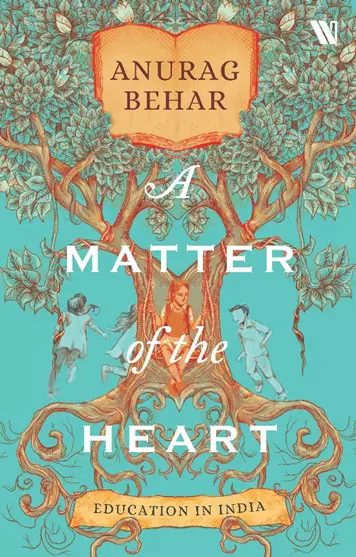Schooling in the hinterland
A Matter of the Heart is a life-affirming collection of essays by Anurag Behar, through which he takes readers to schools in villages, allowing them to experience the shortcomings and see how communities are bridging the gulf. Excerpts:

As I waited to meet the principal, the teacher’s voice drifted out from the open classroom window. It was a dark room with the children on the floor. I couldn’t make out more from the outside. The voice was repeating, ‘Kanha is a national park. It is open till 6 p.m. in the summers and 4 p.m. in the winters.’ After three repetitions, he instructed the children to repeat after him, which they did.
In a small town in Karnataka, a thousand kilometres away, the complete irrelevance of Kanha’s opening hours is obvious. The dark room and the disembodied voice unwittingly portrayed a caricature that is often real, of teaching in India. All our stated educational policies and curricular approaches are dead against this kind of meaningless activity that passes as education. However, in the classrooms of this country, far and near from where these policies are made, this routine goes on.
The principal (and owner) was in his early thirties. We sat in a small room, which opened onto a narrow street. This was the only way in to the school; it was his control cabin. He narrated with some relish his success in building the school, starting with his disinterest in the family trading business and the desire to start a new one. He had some hesitation in talking about the economics of his school, but eagerly shared his triumph in being able to attract children from nearby villages within a radius of 6 km. In the half an hour that we were with him, we saw the effectiveness of his control cabin in managing his teachers, helpers and suppliers. We left him perched at his cash-counter, chatting with no interest with someone who had strolled in with no purpose.
In another small town, in Rajasthan, we were leaving another school. The principal was walking with us across the neatly maintained school garden to see us off. The little girl was in all red, both her thumbs in her mouth, perched on a platform built around a grand peepal tree.
She just kept staring at us wide-eyed. She is four years old, too young for school. Her mother had passed away a year ago; her father is a labourer. Her two brothers study in the school. With no one else at home, only they can take care of her. So Kaniram, the principal, has asked her father to send her to school, so that the brothers don’t miss school. She hangs around the whole day and eats the school’s mid-day-meal. Kaniram also arranges clothes for her.
Kaniram told me the story of the peepal. When he was transferred to the school, the tree was full of red flags, rotting flowers and decaying offerings. It was a totem, like many a peepal tree. But it was inside the government upper-primary school. Not only was it dirtying the place, but it would attract crowds who had no reason to enter the school. He got the flags and everything else out of the school, and burnt the heap. He was told by the horrified people about all the plagues that would visit them as retribution. His response was, ‘The plagues will visit me, not you, don’t worry.’
He uses less extreme methods to keep his school the way it is. It’s an acre of leafy oasis, with fresh-smelling rooms and toilets with running water; a clean well-lit place. Aside from using his budgets well, he cajoles local people in the town, and also those who have migrated out, to contribute to the school. That’s how he built the platform around the peepal, and is also able to organise an honorarium for a retired official, who helps with Class I, since the school has only four teachers to handle 245 children across the eight classes. His approach is ‘negotiate for more resources from the outside, but must manage with what is there; the children can’t suffer’
All teachers in his school need to be able to teach all subjects. He regrets that experienced colleagues who had become really good teachers were transferred out, but gets on with developing the new teachers who have joined. We saw the Class VIII students working in a group, learning from each other. He doesn’t know in-vogue phrases like ‘peer-learning’ for this, but gets it done. He politely refused to accept my compliments saying, ‘This is my job, and every one of us has enough space to do it, if we want to.’
The first anecdote is constructed from experiences in a few schools, and is not about a specific school. That’s deliberate because I don’t want to sit in judgement based on brief interactions. However, such experiences are all too common. Schools driven by profit don’t bother much about education, or about their students. Not all private schools are like this, nor do all government schools have a Kaniram. But without doubt, too many schools are run like cash counters. Fortunately, there are also enough people like Kaniram, with whom lies the hope for education.
13 November 2013
(Excerpted with permission from Anurag Behar’s ‘A Matter of the Heart’; published by Westland Books)



